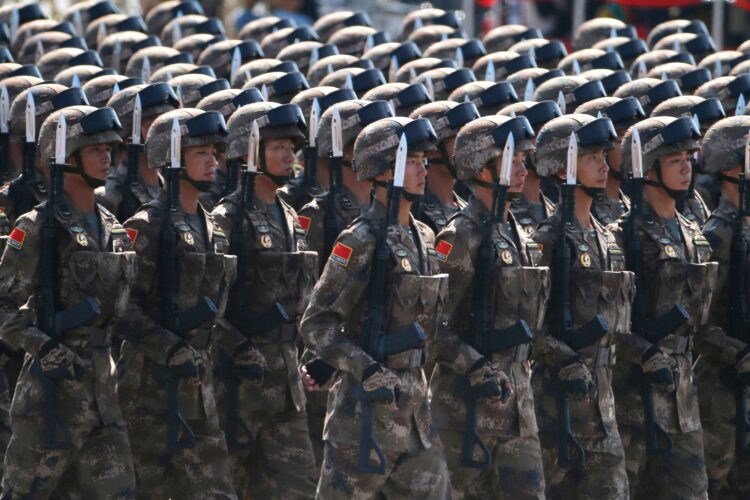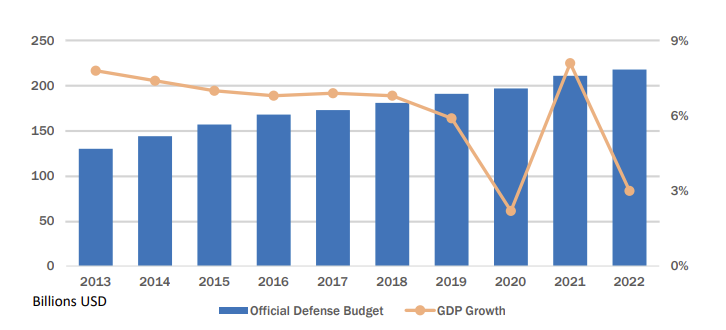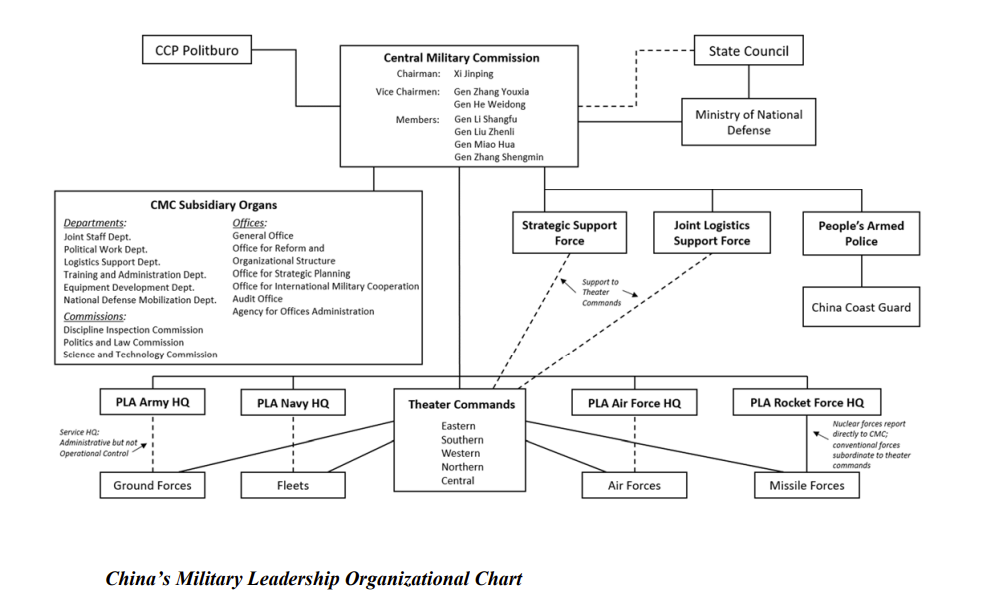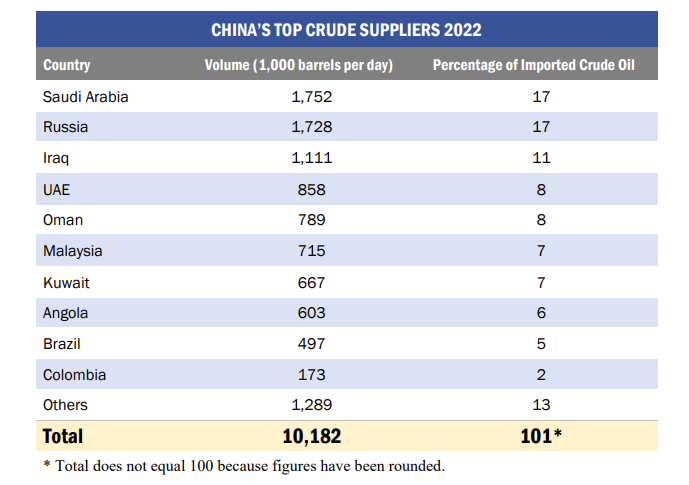Last week, the U.S. Department of Defense (DoD) released a report analyzing how China intends to become a global powerhouse by 2049 through economic independence, technological supremacy, and geopolitical mastery. The document aims to build on the Biden administration’s 2022 claim that the People’s Republic of China (PRC) is the “only competitor to the United States with both the intent to reshape the international order and, increasingly, the economic, diplomatic, military, and technological power to advance that objective.”
Entitled “Military Security and Developments Involving the People’s Republic of China,” the report is released annually and is sent to lawmakers as part of a Congress-mandated program to assess the status of China with a focus on its military. It cost the DoD approximately $178,000 to produce.
In addition to analyzing improvements to the People’s Liberation Army (PLA) and its technological developments, the report also discusses the China’s strategies both regionally and globally.
(RELATED: China vs Taiwan – What Will Happen if China Invades?)
The DoD’s summary reads:
The report finds that in 2022, the PRC increasingly turned to the PLA as an instrument of statecraft. Throughout the year, the PLA adopted more coercive actions in the Indo-Pacific region, while accelerating its development of capabilities, including its nuclear, space, and cyberspace capabilities; deepening military ties with Russia; and strengthening its ability to project power in the Indo-Pacific region and globally. At the same time, the PRC largely denied, cancelled, and ignored recurring bilateral defense engagements, as well as DoD requests for military-to-military communication at multiple levels.
We decided to take a deeper dive into the document and bring the most significant passages to the surface.
War and Military:
- The national strategy of the PRC is to achieve “the great rejuvenation of the Chinese nation” by 2049 (II, 1), defined in part by “unifying” Taiwan by force with mainland China (2, 136) as well as solidifying full PRC control of Hong Kong. (3) China is also preparing to deter the U.S. and any other third-party powers from interfering with its “unification” operation with Taiwan. (136)
- PRC leaders have begun stressing the imperative to turn PLA into a “world-class” military by 2049. (IV)
- The PLA is committed to readying itself to “fight and wins wars” against a “strong enemy” (“a likely euphemism for the United States”) and project power on a global scale. (V)
- The PRC has numerically the largest navy in the world with over 370 ships and submarines and over 140 major surface combatants. Its air force is also rapidly catching up. (V) Meanwhile, it continues to invest in amphibious warfare ships which shows an intent for “expeditionary” warfare. (57)
- The PRC continues to develop anti-satellite missiles, electronic warfare systems, and direct-energy systems to be used in space. (VI) It is trying to turn outer space technological development into a profit-generating industry, and has devoted significant portions of its economic power to do so. (98-99)
- China’s military has developed a long-range fire capability, which it demonstrated after a 2022 U.S. Congressional envoy visited Taiwan. (48)
- PRC has ships deployed in disputed areas near Scarborough Reef, Thitu Island, and the “Nine-Dash Line.” (IX) It views U.S. activity in the South China Sea as “destabilizing.” (7, 125)
(WATCH: Patrick Bet-David breaks down the Nine-Dash Line)
- Between Fall 2021 and Fall 2023, the U.S. has documented over 180 instances of PLA “coercive and risky” air intercepts against American aircraft, more than the entire past decade. (X)
(RELATED: Pentagon Declassifies Footage of “Unsafe” Encounters with Chinese Fighter Jets)
- China has begun conducting military activities in spaces owned by the United States. It has vocally protested when the United States conducted military activities in its Exclusive Economic Zone (EEZ), which is legally permitted in the rules of international law as reflected in the United Nations Conventions on the Law of the Sea. (52) It aims to reduce or cease altogether such lawful operations by the U.S. through military pressure and insistence on PRC power. (138)
- China is enhancing its nuclear-capable missile forces with new Intercontinental Ballistic Missiles (ICBMs). (66) The DoD estimates China has more than 500 operational nuclear warheads in 2023. (104) China currently has a “no first use” policy, meaning it will never use nuclear weapons first in a conflict and holds onto them solely to deter adversarial nuclear powers. (105)
Learn the benefits of becoming a Valuetainment Member and subscribe today!
Psychological and Alternative Forms of Warfare:
- China is continuing to develop its concept of “Three Warfares” comprised of “psychological warfare,” “public opinion warfare,” and “legal warfare.” (71) The DoD has a whole chapter on the topic on psychological warfare in its 2022 Report, “Special Topic: PRC Views of Information and Information Dominance.”
- In 2022, PLA continued discussions of a new “core operational concept” known as Multi-Domain Precision Warfare (MDPW), which uses data collections and AI to assess weak points in the United States’ operational system with the intention to attack them with precision strikes. (IV)
- China is developing AI weapons and other tools that make use of advanced technology for “intelligentized warfare,” as well as cyberspace attack abilities. It currently possesses the ability to disrupt American natural gas pipelines for days and even weeks. (VII, 93-94)
- PRC military medical institutions continue to study potent toxins with dual use applications, raising concerns about their compliance with the Biological Weapons Convention (BWC). (IX)
- PRC is also researching pharmaceutical-based agents (BPAs) and toxins with potential dual-use applications. The U.S. cannot verify if they follow Chemical Weapons Convention (CWC) protocol. (IX, 114)
- The PLA sees Electronic Warfare (EW) as key. It aims to “paralyze the enemy’s operational system of systems” and “sabotage the enemy’s war command system of systems’ early in a conflict. (95)
- The PLA has plans for next-generation intelligentized warfare including “attrition warfare by intelligent swarms, cross-domain mobile warfare, AI-based space confrontation, and cognitive control operations.” (97)
Economics:
- China is intensifying its preparations for total financial and technological independence due to Western sanctions placed on Russia. (XI) China has become a willing buyer of Russian energy exports to prop up the nation as it deals with Western Sanctions and has seen to it that Russia’s presence is felt in its multilateral organizations. (15) Chinese officials continually face legal proceedings from the U.S. over accusations of espionage and intellectual property theft as they race to become independent in key technologies. (22) China is also striving for greater independence in industrial fields like “aerospace, communications, and transportation.” (31)
(RELATED: Semiconductor Chip War: America’s Edge Over China)
- China’s economic growth has slowed. It had been slowing before the pandemic hit, and 2022 was its worse year for growth since 1976. (20)
- China is concerned about its housing market and is weighing how much more state funding needs to be disbursed to correct it. (21)
(RELATED: China’s Catastrophic Economic Crisis – Is The Bubble About To Burst?)
International Relations:
- PRC has said in its 20th Party Congress Political Work Report that times of “turbulent international climate” are on the way. (2)
- China thinks of the U.S. as the “principal instigator” of global instability. (7)
- China considers Pakistan its only “all-weather strategic partner,” Russia as its only “comprehensive strategic partner with coordination relations,” and countries like Brazil and various nations in South Asia as holding “all-around strategic partnership relations.” (12)
- The PRC resents Washington’s “exaggerated threat picture” of China and is trying to increase its favor among developing countries to counteract the messaging. (13) It has also established media outlets to push news in English, Spanish, French, Russian and other languages. (16)
- Chinese firms have exported over $12 million worth of drones to Russia which have been employed in the Ukraine War. (15) It seeks to amplify its degree of military cooperation with Russia. (16)
Social and Cultural:
- The PRC has passed new legislation that enables it to violate people’s data privacy. Additionally, the PRC has granted itself the authority to force any private Chinese company to turn over all data collected by their systems at whim, on grounds of national security. (27)
(RELATED: TikTok’s US Branch is Being Filled with High-Ranking Personnel from China)
Here is the full document for reading and download:
Patrick Bet-David explains the volatile situation between China and Taiwan. What would happen if China invaded the island country? Why is China building fake islands right now?























Add comment